The global super calendered glassine paper market is valued at USD 1,400.6 million in 2025 and is projected to reach USD 2,175.1 million by 2035, recording an absolute increase of USD 774.5 million over the forecast period. This translates into total growth of 55.3% with a CAGR of 4.5%, reflecting expansion by nearly 1.6X. Growth is being driven by the increasing demand for precision-engineered substrates in release liners, packaging, and industrial applications where consistent performance and quality are paramount. Super calendered glassine paper has become a critical material due to its smooth surface, high density, and dimensional stability, enabling superior coating and release performance compared to conventional substrates.
The food packaging sector is one of the primary contributors to market expansion. Glassine paper provides excellent grease resistance, smoothness, and strength, making it suitable for bakery, confectionery, and quick-service restaurant packaging. With rising consumption of packaged food worldwide, demand for glassine-based laminates and wraps continues to expand. Pharmaceutical labeling is another major growth driver, with high regulatory standards requiring reliable substrates that allow precision printing, adhesion, and resistance to contamination. Glassine paper’s ability to meet stringent compliance requirements makes it a preferred material in this segment. The industrial tape industry also represents a significant demand source, as the paper is widely used as a release liner in double-sided and specialty adhesive tapes, particularly for automotive, electronics, and construction sectors.
Technological advancements in calendering and coating processes are enhancing product quality, with improvements in opacity, transparency, and barrier properties supporting its adoption in premium applications. Producers are focusing on innovation in surface uniformity and improved release coatings, enabling greater performance in silicone coating and specialty adhesive applications. Furthermore, sustainability trends in the paper and packaging industry are influencing the super calendered glassine paper market, as manufacturers shift toward recyclable and biodegradable solutions. Glassine paper, being cellulose-based and recyclable, benefits from the growing industry and consumer preference for eco-friendly alternatives compared to synthetic films.
Regional adoption patterns highlight a strong base in Europe, where mature packaging and labeling industries sustain consistent demand. North America follows closely, supported by the food, healthcare, and tape industries, while Asia Pacific is anticipated to register the fastest growth. Expansion of packaging manufacturing, rising exports of industrial products, and increasing consumer goods production in China, India, and Southeast Asia are expected to create substantial opportunities. Latin America and the Middle East are smaller but emerging markets, where food packaging and industrial distribution channels are gradually expanding.
The competitive landscape is characterized by a mix of global paper manufacturers and specialized producers that focus on quality consistency and supply reliability. Differentiation comes from offering tailored grades for specific end-use industries, strengthening distribution networks, and ensuring compliance with food-contact and pharmaceutical standards. Long-term contracts with adhesive and labeling companies have become a key strategy to secure market share.
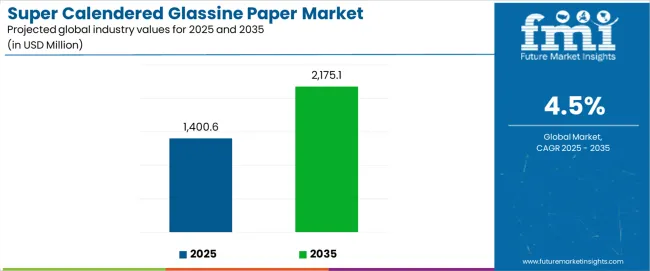
Between 2025 and 2030, the super calendered glassine paper market is projected to expand from USD 1,400.6 million to USD 1,745.4 million, resulting in a value increase of USD 344.8 million, which represents 44.5% of the total forecast growth for the decade. This phase of development will be shaped by increasing demand for specialized coating formulations, rising industrial tape consumption patterns enabling precision adhesive applications, and growing availability of advanced calendering technologies across commercial paper production and specialty coating facilities.
Between 2030 and 2035, the super calendered glassine paper market is forecast to grow from USD 1,745.4 million to USD 2,175.1 million, adding another USD 429.7 million, which constitutes 55.5% of the ten-year expansion. This period is expected to be characterized by the advancement of barrier enhancement technologies, the integration of high-gloss finishing systems for premium applications, and the development of specialized release characteristics across diverse labeling categories. The growing emphasis on functional coating performance and manufacturing precision will drive demand for advanced glassine varieties with enhanced smoothness properties, improved chemical resistance, and superior release functionality characteristics.
Between 2020 and 2024, the super calendered glassine paper market experienced steady growth, driven by increasing consumer demand for high-quality labeling solutions and growing recognition of glassine paper's effectiveness in supporting precise release liner applications across food service and pharmaceutical sectors. The super calendered glassine paper market developed as businesses recognized the potential for super calendered glassine paper to deliver exceptional surface smoothness while meeting modern requirements for moisture resistance properties and cost-effective production patterns. Technological advancement in calendering processes and coating formulation practices began emphasizing the critical importance of maintaining paper uniformity while enhancing manufacturing efficiency and improving material performance.
| Metric | Value |
|---|---|
| Estimated Value in (2025E) | USD 1,400.6 million |
| Forecast Value in (2035F) | USD 2,175.1 million |
| Forecast CAGR (2025 to 2035) | 4.5% |
The packaging materials market is the largest contributor, accounting for approximately 30-35%. Super calendered glassine paper, known for its smooth, glossy finish and high resistance to moisture, grease, and air, is widely used in the packaging of food products, pharmaceuticals, and cosmetics, where barrier properties and aesthetic appeal are crucial. As demand for eco-friendly and high-quality packaging materials rises, glassine paper remains a popular choice for manufacturers looking to provide enhanced product protection and branding. The labeling and adhesive materials market contributes around 20-25%, as glassine paper is commonly used as a liner material in pressure-sensitive labels, providing excellent printability and durability.
The printing and publishing market holds approximately 15-18%, as super calendered glassine paper is used in the production of printed materials such as booklets, brochures, and magazines. Its smooth surface and ability to hold ink well make it an ideal choice for high-quality printing applications. The food and beverage market contributes about 12-15%, where glassine paper is used in the packaging of snacks, baked goods, and confectionery, providing grease and moisture resistance while maintaining a lightweight and functional design. The textile and fashion market represents about 8-10%, as glassine paper is used for protective packaging of garments and textiles, especially during shipping and storage.
Market expansion is being supported by the increasing global demand for precision release liner solutions and the corresponding shift toward high-performance specialty papers that can provide superior smoothness characteristics while meeting user requirements for chemical resistance and cost-efficient production processes. Modern businesses are increasingly focused on incorporating paper grades that can enhance converting efficiency while satisfying demands for consistent, reliably performing release liners and optimized manufacturing practices. Super calendered glassine paper's proven ability to deliver exceptional surface quality, moisture barrier properties, and diverse application possibilities makes them essential materials for label manufacturers and quality-conscious converting operations.
The growing emphasis on high-precision labeling applications and production scalability is driving demand for advanced super calendered glassine paper systems that can support distinctive product positioning and comprehensive performance differentiation across adhesive tape, food packaging, and pharmaceutical labeling categories. User preference for papers that combine functional excellence with processing flexibility is creating opportunities for innovative implementations in both traditional and emerging specialty paper applications. The rising influence of automated converting equipment and modern production infrastructure is also contributing to increased adoption of super calendered glassine papers that can provide authentic performance benefits and reliable supply characteristics.
The super calendered glassine paper market is segmented by type of coating, application, and region. By type of coating, the super calendered glassine paper market is divided into double-sided coating, single-sided coating, and others. Based on application, the super calendered glassine paper market is categorized into labels and tapes, oil resistant packaging, and others. Regionally, the super calendered glassine paper market is divided into Asia Pacific, Europe, North America, Latin America, Middle East & Africa, and other regions.
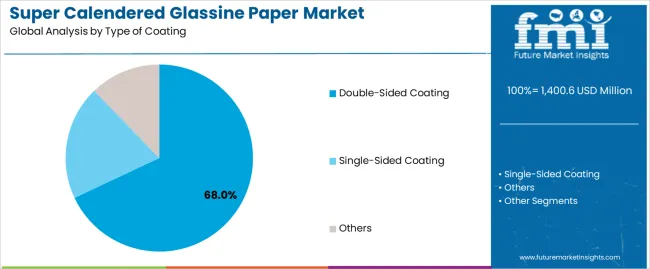
The double-sided coating segment is projected to account for 68% of the super calendered glassine paper market in 2025, reaffirming its position as the leading product category. Businesses and converting facilities increasingly utilize double-sided coating papers for their superior release performance characteristics, established processing efficiency, and essential functionality in demanding release liner applications across multiple product categories. Double-sided coating papers' standardized manufacturing characteristics and proven cost-effectiveness directly address user requirements for reliable paper performance and optimal processing value in commercial applications.
This coating segment forms the foundation of modern super calendered glassine paper production patterns, as it represents the format with the greatest commercial versatility potential and established compatibility across multiple converting systems. Business investments in coating technology and quality standardization continue to strengthen adoption among efficiency-conscious manufacturers. With users prioritizing release consistency and material optimization, double-sided coating papers align with both economic objectives and performance requirements, making them the central component of comprehensive specialty paper strategies.
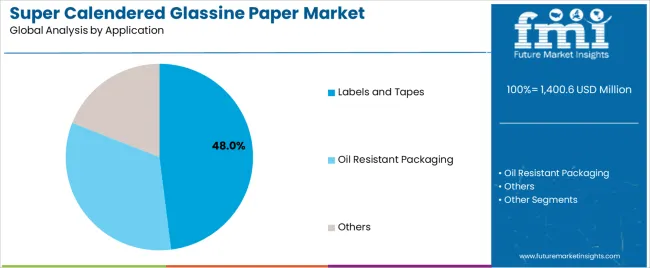
Labels and tapes is projected to represent 48% of the super calendered glassine paper market in 2025, underscoring its critical role as the primary application for quality-focused businesses seeking superior release liner benefits and enhanced converting convenience credentials. Commercial users and label manufacturers prefer labels and tapes applications for their established market patterns, proven performance acceptance, and ability to maintain exceptional precision profiles while supporting versatile product offerings during diverse converting experiences. Positioned as essential applications for discerning manufacturers, labels and tapes offerings provide both market penetration excellence and production positioning advantages.
The segment is supported by continuous improvement in coating enhancement technology and the widespread availability of established quality frameworks that enable precision converting compliance and premium positioning at the commercial level. Converting companies are optimizing paper specifications to support market differentiation and accessible pricing strategies. As coating technology continues to advance and manufacturers seek reliable release liner formats, labels and tapes applications will continue to drive market growth while supporting brand recognition and customer satisfaction strategies.
The super calendered glassine paper market is advancing rapidly due to increasing precision coating consciousness and growing need for high-performance release liner choices that emphasize superior material performance outcomes across labeling segments and packaging applications. The super calendered glassine paper market faces challenges, including competition from synthetic release liners, cost pressures from raw material fluctuations, and technological requirements affecting production economics. Innovation in coating formulation systems and advanced calendering technologies continues to influence market development and expansion patterns.
The growing adoption of super calendered glassine paper in food packaging products and industrial tape applications is enabling businesses to develop converting patterns that provide distinctive barrier protection benefits while commanding commercial acceptance positioning and enhanced processing characteristics. Food packaging applications provide superior grease resistance properties while allowing more sophisticated moisture barrier features across various product categories. Users are increasingly recognizing the functional advantages of glassine paper positioning for premium product protection and efficiency-conscious converting integration.
Modern super calendered glassine paper manufacturers are incorporating advanced coating technologies, precision calendering systems, and automated quality control systems to enhance performance credentials, improve manufacturing consistency outcomes, and meet commercial demands for reliable specialty paper solutions. These systems improve processing effectiveness while enabling new applications, including enhanced release value certification and performance traceability programs. Advanced coating integration also allows manufacturers to support technical leadership positioning and customer satisfaction beyond traditional paper operations.
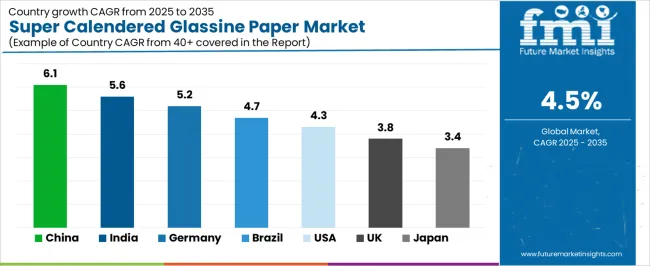
| Country | CAGR (2025-2035) |
|---|---|
| China | 6.1% |
| India | 5.6% |
| Germany | 5.2% |
| Brazil | 4.7% |
| USA | 4.3% |
| UK | 3.8% |
| Japan | 3.4% |
The super calendered glassine paper market is experiencing robust growth globally, with China leading at a 6.1% CAGR through 2035, driven by the expanding packaging industry, growing label manufacturing sector, and increasing adoption of specialty paper applications. India follows at 5.6%, supported by rising converting industry trends, expanding industrial infrastructure, and growing acceptance of high-performance release liner solutions. Germany shows growth at 5.2%, emphasizing established paper manufacturing capabilities and comprehensive specialty paper development. Brazil records 4.7%, focusing on growing packaging applications and industrial expansion. The USA demonstrates 4.3% growth, prioritizing precision converting solutions and technological advancement.
The report covers an in-depth analysis of 40+ countries, with top-performing countries highlighted below.
Revenue from super calendered glassine paper consumption and sales in China is projected to exhibit exceptional growth with a CAGR of 6.1% through 2035, driven by the country's rapidly expanding packaging sector, favorable industrial attitudes toward precision specialty papers, and initiatives promoting manufacturing optimization across major production regions. China's position as a leading industrial market and increasing focus on high-performance paper development are creating substantial demand for quality super calendered glassine papers in both commercial and specialty markets. Major converting companies and paper manufacturers are establishing comprehensive production capabilities to serve growing demand and emerging market opportunities.
Demand for super calendered glassine paper products in India is growing at a CAGR of 5.6%, supported by rising packaging sophistication, growing label manufacturing requirements, and expanding converting infrastructure. The country's developing industrial capabilities and increasing commercial investment in advanced paper technologies are driving demand for super calendered glassine papers across both imported and domestically produced applications. International paper companies and domestic converters are establishing comprehensive operational networks to address growing market demand for quality glassine papers and efficient specialty paper solutions.
Revenue from super calendered glassine paper products in Germany is expanding at a CAGR of 5.2% through 2035, supported by the country's advanced paper manufacturing market, established converting culture, and leadership in specialty paper standards. Germany's sophisticated supply chain infrastructure and strong support for technical innovation are creating steady demand for both traditional and innovative super calendered glassine paper varieties. Leading specialty paper brands and precision converters are establishing comprehensive operational strategies to serve both domestic markets and growing export opportunities.
Demand for super calendered glassine paper products in Brazil is projected to grow at a CAGR of 4.7% through 2035, driven by the country's emphasis on packaging expansion, regional manufacturing leadership, and developing production capabilities for papers requiring specialized coating varieties. Brazilian manufacturers and distributors consistently seek commercial-grade specialty papers that enhance product differentiation and support converting operations for both traditional and innovative industrial applications. The country's position as a Latin American manufacturing leader continues to drive innovation in specialty glassine paper applications and commercial production standards.
Revenue from super calendered glassine paper products in the USA is expected to expand at a CAGR of 4.3% through 2035, supported by the country's emphasis on precision converting, specialty paper standards, and advanced technology integration requiring efficient paper solutions. American businesses and converting brands prioritize material performance and manufacturing precision, making super calendered glassine papers essential materials for both traditional and modern industrial applications. The country's comprehensive technology excellence and advancing specialty paper patterns support continued market expansion.
Demand for super calendered glassine paper products in the UK is anticipated to grow at a CAGR of 3.8% through 2035, supported by established converting markets, quality-focused applications, and comprehensive specialty paper infrastructure. The country's mature industrial base and emphasis on precision manufacturing are creating consistent demand for high-performance super calendered glassine paper varieties. Leading paper companies and specialty converters are establishing operational capabilities to address both domestic requirements and export market opportunities.
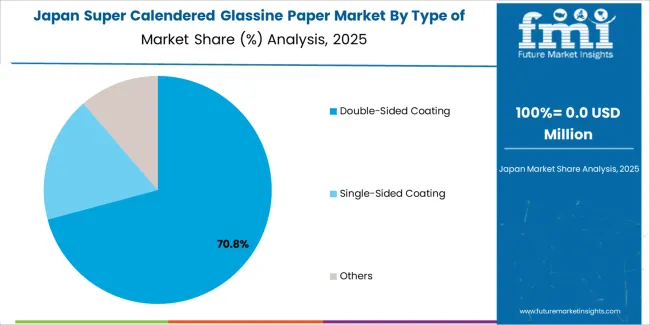
Revenue from super calendered glassine paper products in Japan is expanding at a CAGR of 3.4% through 2035, supported by the country's emphasis on precision manufacturing, technical standards, and advanced quality integration requiring specialized paper solutions. Japanese businesses and industrial brands prioritize material performance and production precision, making super calendered glassine papers essential materials for both traditional and advanced converting applications. The country's comprehensive technical excellence and advancing specialty paper patterns support continued market development.
The Europe super calendered glassine paper market is projected to grow from USD 522.7 million in 2025 to USD 816.2 million by 2035, recording a CAGR of 4.6% over the forecast period. Germany leads the region with a 38.5% share in 2025, moderating slightly to 37.8% by 2035, supported by its strong paper manufacturing base and demand for precision-engineered specialty paper products. The United Kingdom follows with 19.2% in 2025, easing to 18.7% by 2035, driven by a mature converting market and emphasis on quality and technical efficiency standards. France accounts for 16.8% in 2025, rising to 17.3% by 2035, reflecting steady adoption of advanced coating solutions and converting optimization. Italy holds 12.5% in 2025, expanding to 13.2% by 2035 as packaging innovation and specialty paper applications grow. Spain contributes 8.3% in 2025, growing to 8.7% by 2035, supported by expanding industrial sector and precision paper handling. The Nordic countries rise from 3.2% in 2025 to 3.5% by 2035 on the back of strong technical adoption and advanced manufacturing technologies. BENELUX remains at 1.5% share across both 2025 and 2035, reflecting mature, efficiency-focused markets.
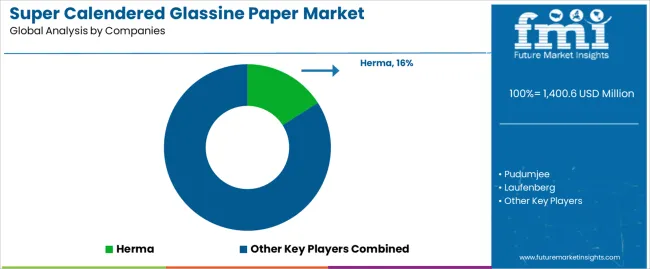
The super calendered glassine paper market is characterized by competition among established specialty paper manufacturers, precision coating producers, and integrated material solution companies. Companies are investing in advanced calendering technologies, specialized coating formulation systems, product innovation capabilities, and comprehensive distribution networks to deliver consistent, high-quality, and reliable super calendered glassine paper systems. Innovation in surface enhancement, barrier property methods, and application-specific product development is central to strengthening market position and customer satisfaction.
Herma leads the super calendered glassine paper market with a strong focus on precision paper innovation and comprehensive super calendered glassine solutions, offering commercial specialty paper systems with emphasis on manufacturing excellence and technical heritage. Pudumjee provides specialized paper capabilities with a focus on regional market applications and coating engineering networks. Laufenberg delivers integrated specialty paper solutions with a focus on converting positioning and operational efficiency. Sappi specializes in comprehensive paper manufacturing with an emphasis on commercial applications. Cheever Specialty Paper & Film focuses on comprehensive industrial and converting papers with advanced coating and premium positioning capabilities.
The success of super calendered glassine papers in meeting commercial specialty paper demands, converter-driven precision requirements, and performance integration will not only enhance converting outcomes but also strengthen global specialty paper manufacturing capabilities. It will consolidate emerging regions' positions as hubs for efficient paper production and align advanced economies with commercial specialty paper systems. This calls for a concerted effort by all stakeholders -- governments, industry bodies, manufacturers, distributors, and investors. Each can be a crucial enabler in preparing the super calendered glassine paper market for its next phase of growth.
How Governments Could Spur Local Production and Adoption?
How Industry Bodies Could Support Market Development?
How Distributors and Converting Industry Players Could Strengthen the Ecosystem?
How Manufacturers Could Navigate the Shift?
| Items | Values |
|---|---|
| Quantitative Units (2025) | USD 1,400.6 million |
| Type of Coating | Double-sided Coating, single-sided Coating, Others |
| Application | Labels and Tapes, Oil Resistant Packaging, Others |
| Regions Covered | Asia Pacific, Europe, North America, Latin America, Middle East & Africa, Other Regions |
| Countries Covered | China, India, Germany, Brazil, United States, United Kingdom, Japan, and 40+ countries |
| Key Companies Profiled | Herma, Pudumjee, Laufenberg, Sappi, Cheever Specialty Paper & Film, and other leading super calendered glassine paper companies |
| Additional Attributes | Dollar sales by type of coating, application, and region; regional demand trends, competitive landscape, technological advancements in calendering engineering, coating integration initiatives, barrier enhancement programs, and premium product development strategies |
The global super calendered glassine paper market is estimated to be valued at USD 1,400.6 million in 2025.
The market size for the super calendered glassine paper market is projected to reach USD 2,175.1 million by 2035.
The super calendered glassine paper market is expected to grow at a 4.5% CAGR between 2025 and 2035.
The key product types in super calendered glassine paper market are double-sided coating , single-sided coating and others.
In terms of application, labels and tapes segment to command 48.0% share in the super calendered glassine paper market in 2025.






Full Research Suite comprises of:
Market outlook & trends analysis
Interviews & case studies
Strategic recommendations
Vendor profiles & capabilities analysis
5-year forecasts
8 regions and 60+ country-level data splits
Market segment data splits
12 months of continuous data updates
DELIVERED AS:
PDF EXCEL ONLINE
Superconducting Detector Market Size and Share Forecast Outlook 2025 to 2035
Super Absorbent Polymer Market Size and Share Forecast Outlook 2025 to 2035
Superalloys Market Size and Share Forecast Outlook 2025 to 2035
Super Antioxidant Supplement Market Size and Share Forecast Outlook 2025 to 2035
Superheater Tubes Market Size and Share Forecast Outlook 2025 to 2035
Super Apps Market Size and Share Forecast Outlook 2025 to 2035
Superconducting Quantum Chip Market Size and Share Forecast Outlook 2025 to 2035
Superconducting Materials Market Size and Share Forecast Outlook 2025 to 2035
Superficial Radiation Therapy System Market Size and Share Forecast Outlook 2025 to 2035
The Super Generics Market Is Segmented by Drug Type, Therapeutic Area, Route of Administration and Distribution Channel from 2025 To 2035
Super Generics Industry Analysis in Europe Report - Trends & Innovations 2025 to 2035
Superficial Punctate Keratitis Treatment Market Insights – Demand and Growth Forecast 2025 to 2035
Super Resolution Microscope Market Insights - Size, Share & Forecast 2025 to 2035
Superfood Powders Market Analysis - Size, Share & Forecast 2025 to 2035
Superconducting Magnets Market Growth – Trends & Forecast 2025 to 2035
Supercapacitors Market Report - Trends & Industry Outlook through 2034
Super Barrier Coated Film Market Trends & Forecast 2024-2034
Superfood Market Trends – Growth & Industry Forecast 2024 to 2034
Super Junction MOSFET Market
Superconducting Wire Market

Thank you!
You will receive an email from our Business Development Manager. Please be sure to check your SPAM/JUNK folder too.
Chat With
MaRIA